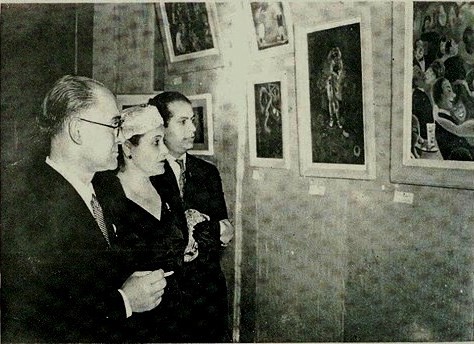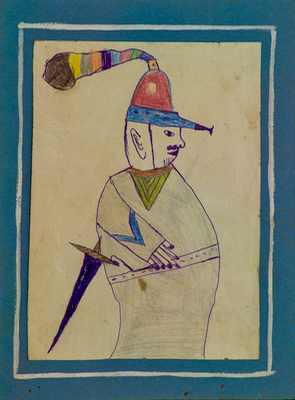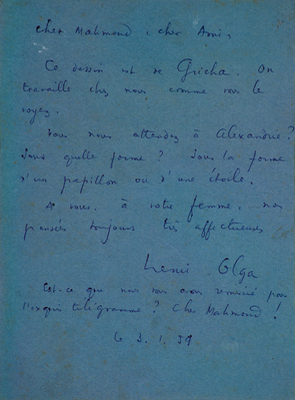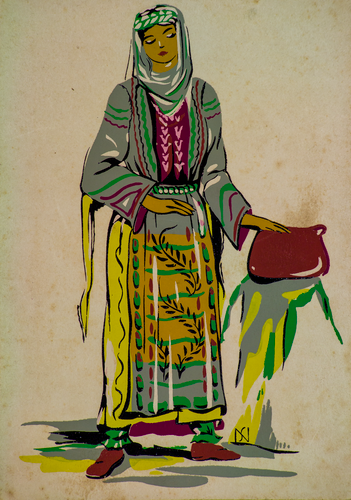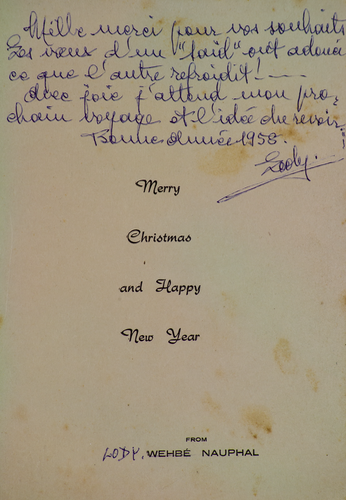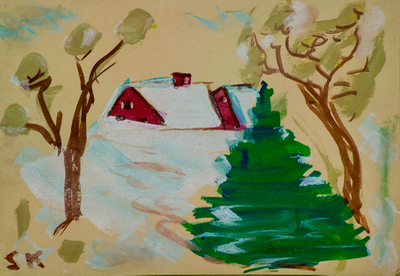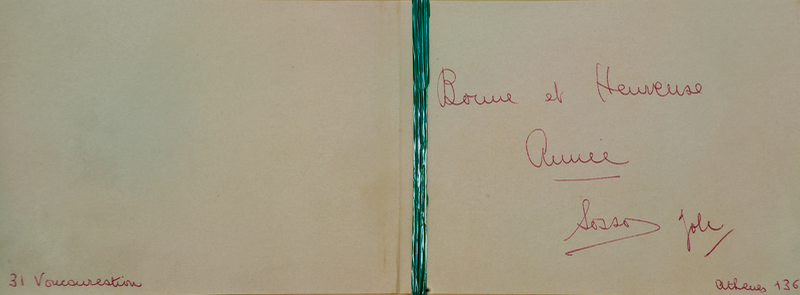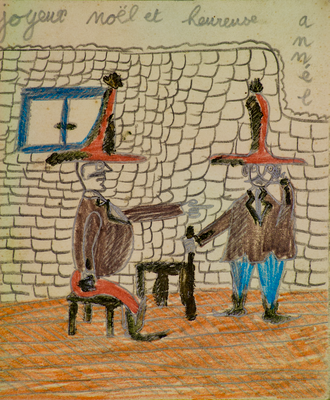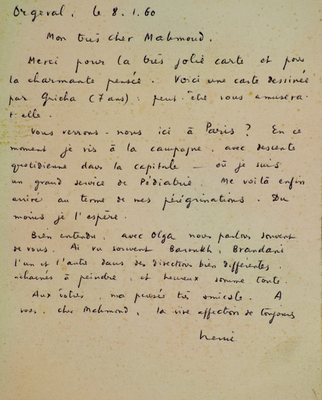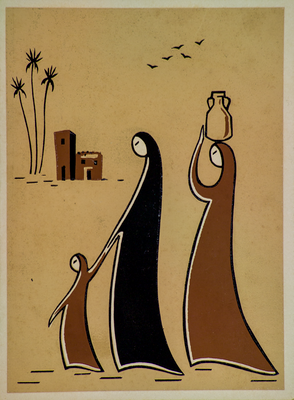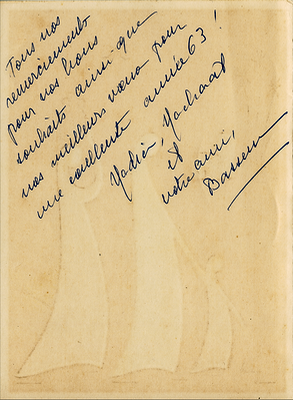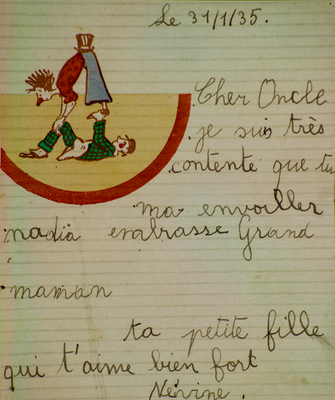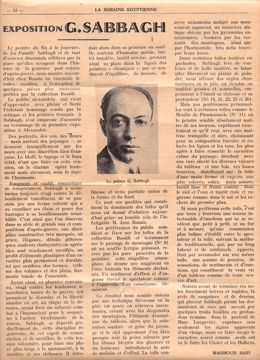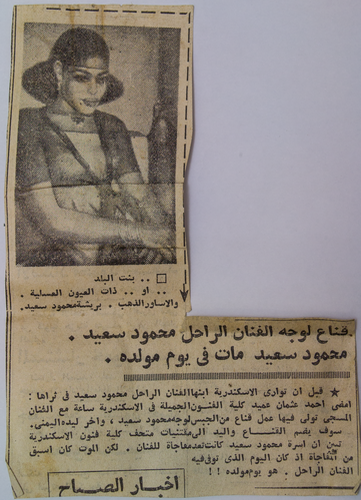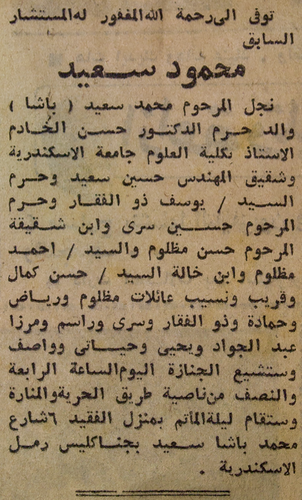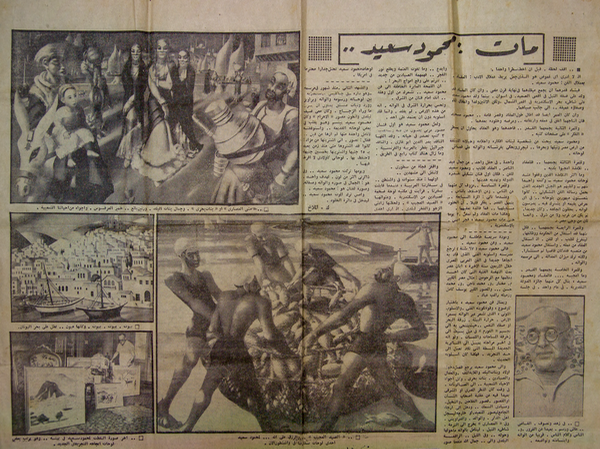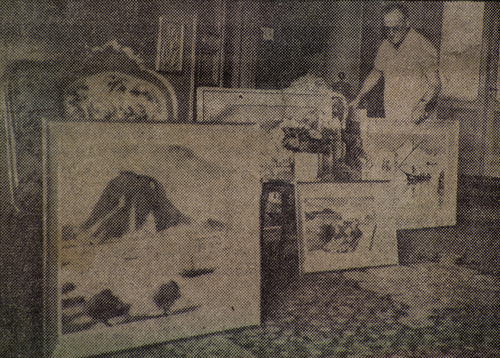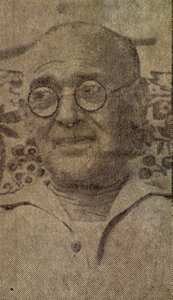THE MAHMOUD SAÏD PROJECT
CATALOGUE RAISONNÉ
NEW DISCOVERIES: ARCHIVES
SINCE THE CATALOGUE RAISONNÉ WAS PUBLISHED
ERRATA |
|||
P 843 Erratum A126: Mahmoud Saïd, his daughter Nadia and her husband Dr. Hassan Elkhadem, early 1960s. |
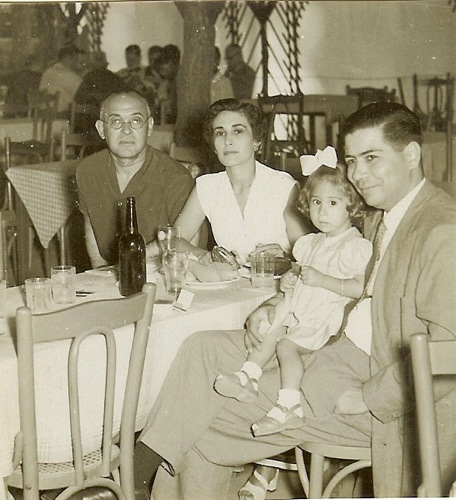 |
||
|
|||
NEW FINDINGS - ARCHIVES |
|||
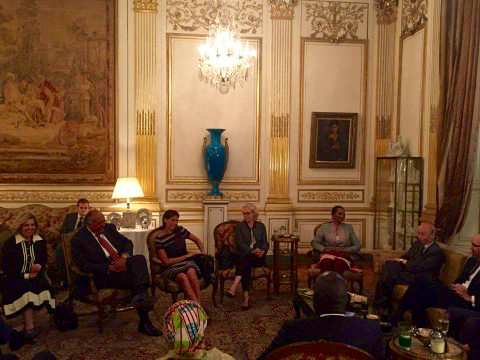 Residence of the Egyptian Ambassador in Paris, France (Hôtel Ephrussi). Meeting attended by H.E. Sameh Shoukry/Egyptian Minister of Foreign Affairs and H.E. Moushira Khattab (2017). Mahmoud Saïd's painting entitled Fatma [P143] appears in the background.
|
|||
|
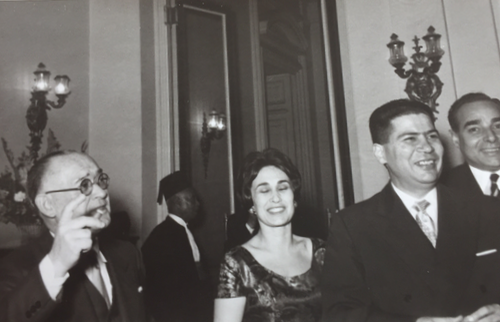 From left to right: Mahmoud Saïd, his daughter Nadia and her husband Saad Elkhadem, circa 1960s. Courtesy Samiha Lamerson |
||
 On the far right, Mahmoud Saïd standing in the foreground, his daughter Nadia in a chequered dress and her mother Samiha Hanem Riad to her right, wearing a hat. Courtesy Samiha Lamerson Paintings in the background (from left to right): Dunes et salines à Marsa Matrouh [P267bis], Le port à Marsa Matrouh [P275], unidentifiable work and La fille aux bijoux [P231] , circa 1950s. |
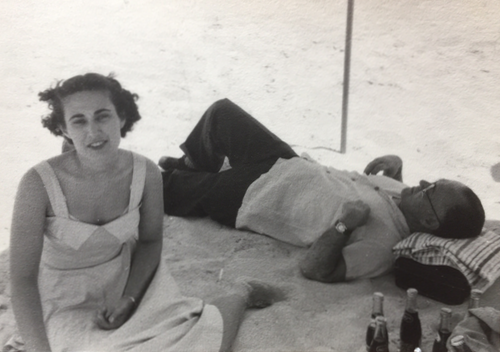 Mahmoud Saïd relaxing and his daughter Nadia, at the beach. Courtesy Samiha Lamerson |
||
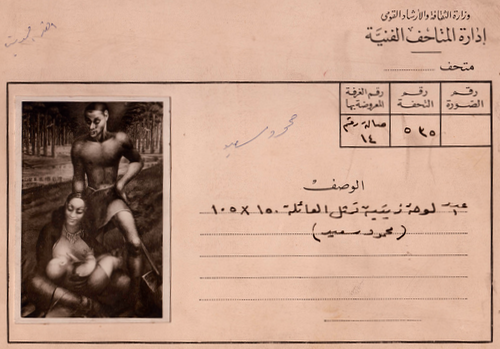 Record for La famille [P175] Courtesy Sherwet Shafei & Safarkhan Gallery, Cairo |
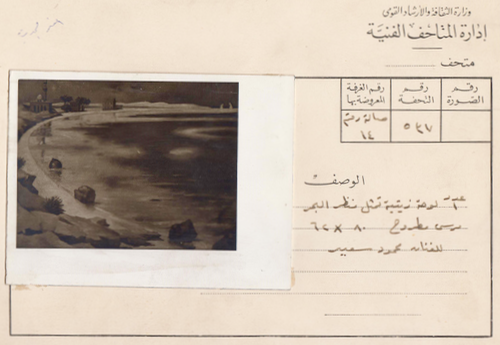 Record for Marsa Matrouh - la baie et les rochers [P270] Courtesy Sherwet Shafei & Safarkhan Gallery, Cairo |
||
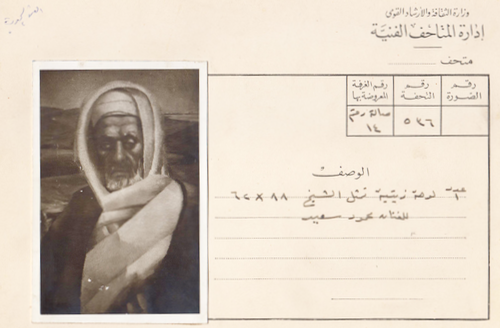 Record for L’homme du Mariout [P162] Courtesy Sherwet Shafei & Safarkhan Gallery, Cairo |
 Greeting card from Artist Roushdy Iskandar to Mahmoud Bek Saïd, 12 May 1962 Courtesy of Sayed Kamel, Alexandria |
||
‘Cher Mahmoud, cher Ami, Ce dessin est de Gricha. On travaille chez nous comme vous le voyez. Vous nous attendez a Alexandrie < Sous quelle forme ? Sous la forme d’un papillon ou d’une etoile ? A vous, a votre femme, nos pensees toujours tres affectueuses. Henri, Olga Est-ce que nous vous avons remercié pour l’exquis télégramme ? Cher Mahmoud ! Le 3.1.59.’ |
‘Mille mercis pour vos souhaits. Les vœux d’un ‘Saïd’ ont adouci ce que l’autre refroidit !... Avec joie j’attends mon prochain voyage et l’idée de revoir. Bonne année 1958. Lody.’ |
||
‘Bonne et Heureuse Année, Sosso / Jole, Athenes 136, 31 Voucourestion’ |
‘Orgeval, le 8.1.60. Mon très cher Mahmoud, Merci pour la très jolie carte et pour la charmante pensée. Voici une carte dessinée par Gricha (7 ans) : peut-être vous amusera-t-elle. Vous verrons-nous ici à Paris ? En ce moment je vis à la campagne, avec descente quotidienne dans la capitale – où je suis un grand service de pédiatrie. Me voilà enfin arrive au terme de mes pérégrinations. Du moins je l’espère. Bien entendu, avec Olga, nous parlons souvent de vous. Ai vu souvent Baroukh, Brandani, l’un et l’autre dans ses directions bien différentes, acharnés à peindre, et heureux somme toute. Aux vôtres, ma pensée très amicale. A vous, cher Mahmoud, la vive affection de toujours. Henri.’ |
||
 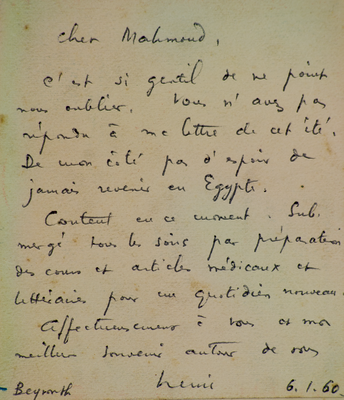 Card from Henri El Kayem to Mahmoud Saïd, sent from Beirut on 6 January 1960. Courtesy of Sayed Kamel, Alexandria ‘Cher Mahmoud, C’est si gentil de ne point nous oublier. Vous n’avez pas répondu à ma lettre de cet été. De mon côté pas d’espoir de ne jamais revenir en Egypte. Content en ce moment. Submergé tous les soirs par préparation de cours et articles médicaux et littéraires pour un quotidien nouveau. Affectueusement à vous et mon meilleur souvenir autour de vous. Henri Beyrouth, 6.1.60.’ ‘Dear Mahmoud, It is so kind of you to not forget us. You did no reply to my letter of this summer. With regards to me, there is no hope of ever coming back to Egypt. Happy at the moment. Submerged every night by the preparation of lectures and medical and literary articles for a new daily newspaper. Affectionately yours and my best regards to those around you. Henri Beirut, 6.1.60.’ |
‘Tous mes remerciements pour vos bons souhaits ainsi que vos meilleurs voeux pour une excellente année 63! Nadia, Nachaat et votre ami Bassem’. |
||
‘Le 31/1/35. Cher Oncle Je suis tres contente que tu ma envoiller [sic] nadia embrasse grand maman. Ta petite fille qui t’aime bien fort. Nevine.’ ’31/1/35. Dear Uncle, I am very happy that you sent me nadia send me love to grandma. Your little girl that loves you very much. Nevine.’ |
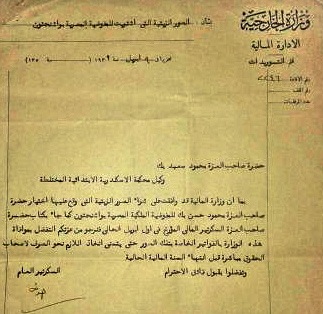 Letter addressed to Mahmoud Saïd Bek from the Ministry of Foreign Affairs (Egypt) dated 9 April 1939, requesting the submission of invoices for artworks purchased by the Ministry of Foreign Affairs for the Egyptian Legation in Washington |
||
| The painter of Nu à la fourrure, of La famille Sabbagh and of so many other works that are now famous given the place they take in the history of Post-War Cubist painting, is showing us today at Ramia’s a group of paintings on loan from the Bassili collection, that have never been publicly displayed before apart from a few of the earliest works. The Alexandrian audience, who had just learned with pride and happiness about Sabbagh being hailed by the French critics and artists, rushed to the opening of his first exhibition in Alexandria. Portraits, nudes, flowers – moreover landscapes – peacefully hang on the walls with a very French discretion. The bluff, the racket and the discordant radiance do not have their place in this exhibition where the charm slowly but surely operates governed by harmony. Full of enthusiasm and excitement, with a romantic character, Sabbagh has always fought against the overflowing torment of his passion through his strong will which enabled him to channel his impetus and put some barriers to his effervescent sensitivity. Hence, one distinguishes in his series of large nudes and post-war compositions a highly emphasised constructive discipline in which grace, elegance, picturesque details, bright or pleasant colours are resolutely put to the profit of aesthetic elements that have a more permanent and solid character such as the synthesis of shapes, the rhythm of volumes and flat areas, and the overall tonal harmony. In that way, as a convinced pioneer, he reacted against the anarchist trends born from the war, that advocated the disorder and total freedom of art to the extent of destroying it. Leading a relentless fight with the unconscious to subject it to the regenerative act of reason, Sabbagh gradually distanced himself from that rigorous discipline, from that attitude of renunciation and | of sacrifice, from that voluntary tension, in order to give more space to spontaneity, to substance and to its wealth. He therefore introduces in his painting a breath of human poetry, that is sometimes troubled, other times calm, hence finding his place alongside the “classical” painters through this sense of balance, measure, delicacy and that perfect union of form and content. These are the qualities dominating the paintings that we can admire today thanks to the laudable zeal of the relentless Mr Jean Ramia. The audience’s preference seems to lean towards the paintings from the Bassili collection, especially the mountain landscape (no. 8) in which a powerful lyrical breeze recreates through the pure painting processes that strange atmosphere of drama which is suggested by destructive elements within the human being. A sense of horror and fear grips the viewer in a similar way that the approach of an imminent cataclysm would. This result appears to have been obtained by a frenetic technique where the paint is applied in ascending stripes, hence creating together with the mountains’ diagonals the dynamic aspect of the painting, whilst the dark and grey colour tones of the landscape and of the oppressing sky of a blue, almost black colour (barely softened by the blueish whites of the glaciers or of the hamlet) introduce the hint of uneasiness and horror. Nevertheless, despite its apparent movement, the painting preserves a static aspect resulting from the criss-crossed pyramids, shaped by the mountains’ slopes as well as by the very distinctly traced horizontal line of their bases. In some of the paintings that have a sketchier approach, Sabbagh overcome with colours and beautiful substance, indulged freely in the pleasure of painting, offering us chromatic orgies in which the paint spreads out in thick and sensual trickles, taking the richness and depth of enamel (nos. 18, 21, 22, 25 and 26). Yet our personal favorites are several works such as the Mill of Ploumanach (no. 11) where the painter seems to perfectly master his means, expressing exactly what he wants, with a confident and calm control. He opts for his linear and coloured composition the lines
|
and colour tones most fit to emphasise the landscape’s peaceful character. He detects the various qualities of the painting with a rare confidence and once these basics have been discovered, he allocates with a firm and expert hand a colourful, sober yet resounding paste, that is sometimes smooth and fluid such as in the sky and the water, and other times hard and coarse such as in the ground and the rocks of the foreground. The reason for preferring this painting is that we can find in it an exhaustible source of emotions that unveil themselves little by little and as and when a more intimate communion is established between the viewer and the painting, following the traditional methodology, that, through tedious toil and perpetual input, ends up by accumulating on a same canvas the sum of thoughts, sensations, feelings and emotions that establish the true life of a painting like any work of art. Let us take note before finishing these unavoidably short and quick remarks, the series of red chalk drawings and other sketches, that place Sabbagh amongst the purebred draughtsmen who, with a few excavated lines (such as in Mrs Langevin’s portrait), know how to express not only the apparent facial features, but also bring out their secret character, in the way achieved only by Clouet and Holbein.
MAHMOUD SAID |
|
Mahmoud Saïd Died on his Birthday. Before Alexandria buried its son, the late artist Mahmoud Saïd, Ahmed Osman, Dean of the Faculty of Fine Arts, Alexandria University, spent an hour with the enshrouded artist to make a mask for his face and another for his right hand. The mask and cast hand will be added to the collection of the Alexandria Faculty of Fine Arts Museum. It turned out that Mahmoud Saïd’s family members were preparing to surprise him with this, but death was quicker. Mahmoud Saïd died on his birthday! Image caption: La Fille aux Yeux Bruns [P232] by Mahmoud Saïd. |
Retired Counselor Mahmoud Saïd has passed. He was son of the late Mohamed Saïd (Pasha); father-in-law of Dr. Hassan al-Khadem, Professor at the Faculty of Science, Alexandria University; brother of Engineer Hussein Said, brother-in-law of Mr. Youssef Zulficar, and brother-in-law of the late Hussein Sirry; nephew of the late Hassan Mazloum and Ahmed Mazloum; and cousin of Hassan Kamal. He is related to Mazloum, Riad, Hamada, Zulficar, Sirry, Rassem, Mirza, Abdul Gawad, Yehia, Hayati, and Wassef families. The funeral will take place today at 4:30 pm, from the corner of El-Hurreya Avenue and Al-Manara. The memorial gathering will be held tonight at the home of the deceased: 6, Mohamed Pasha Saïd Street, Gianaklis, El-Ramleh, Alexandria. |
||
Image caption (to the left)
|
Between asceticism and Sufism, the judge lived and painted. |
||
Translation of the article (by Suzy Beltagy) Mahmoud Saïd is Dead. I stop for a second, before I start writing. I do not know what ambiguity connects the master of literature Al-Aqqad with the master of fine arts Mahmoud Saïd. As fate would have it, both masters were born towards the end of the 20th century. Al-Aqqad was born on the shores of the Nile in Aswan to the south, while Mahmoud Saïd was born on the shores of the Mediterranean in Alexandria to the North. Both of them grew up around clear deep flowing waters. With Al-Aqqad’s long life, and Mahmoud Saïd’s shorter one, their works were equal in depth, value, and immortality. While Al-Aqqad expressed intellectuality through his writings, Mahmoud Saïd searched for a character for the thoughts, dreams, and imagination emerging from the land of Egypt, its Nile, and its seas; later expressing them with his brushes and colours on the canvas of his paintings. Both masters were equally admired for their works. Many apprentices stood before the art of Mahmoud Saïd, and I was one of them. Most admirers were of the new generation that adopted the mission of visual arts. They were amazed by his works whenever they were exhibited. They would analyse his colours and inclinations that were new; not from the West or from the East, but rather from Egypt. Another thing they had in common was that they both quit their government jobs, |
to dedicate their efforts to literature in the case of Al-Aqqad, and to art in the case of Mahmoud Saïd. Al-Aqqad quit his job, and Mahmoud Saïd who was first a judge then a counsellor, also retired to his studio and colours. Furthermore, Al-Aqqad and Mahmoud Saïd both received the State’s Merit Award in the same year and in the same ceremony. Al-Aqqad received the reward for literature, while Mahmoud Saïd received that for art, becoming the first visual artist to be honoured by the state. Both al-Aqqad and Mahmoud Saïd were also not very social people. They stayed away from society. Mahmoud Saïd died yesterday at dawn, in Alexandria, only thirty days after the death of Al-Aqqad. Going back to his art, Mahmoud Saïd had his own art school and artistic methods by which he led a new trend in Egyptian and Arab art during the last forty years, in an age of artistic renaissance led by artists Mahmoud Mokhtar, Mohamed Naghi, Mohamed Hassan, Youssef Kamel, and Ragheb Ayad. The art of Mahmoud Saïd was characterized by its choice of subjects, the power of its compositions, and its colours through which one could feel the colour of the land, the heat of the environment, the blue of the sea, and the clarity of the soul. He was more inclined to the realization of the form, with a slight tendency to decorating the areas and the touches. However, in his final days, he | was more inclined toward the simplified neo-expressionism that was almost abstract. That was his new style. Through his art, Mahmoud Saïd introduced to high society the men and women from popular areas with their traditional clothes, workers, fishermen, and women from the Bahari district, in a time when the Egyptian or Eastern landscape were far from the minds of mansion dwellers and upper-class people. He painted farmers, palm trees, and fishermen; ventured inside mosques to capture the image of worshippers and outside them to paint people practicing Zikr, Mulid-goers, and dervishes. In the afternoons, he would go out to the canals or the Nile shore to contemplate its colours and its surroundings. Then he would contemplate the belly-dancer or the beauty of the night. At dawn, he would watch the fishermen as they worked and sung to the sound of the waves. A quick glimpse at Mahmoud Saïd’s art makes us feel that we stand before an artist from the East. You can sense the heat of the East in his colours, and that he belongs to these lands. He did not imitate, but led through his own style independent of other people. Perhaps Mahmoud Saïd is the first Arab painter for which three books were published during his life; those by art critics Badr El-Din Abu Ghazi and Gabriel Boctor both in Arabic and French. A fourth book is on the way. I leave my lines to go back to two scenes, the first taking place in Washington, during a meeting with the ambassador at our embassy. I saw in his office a huge painting of fishermen from Alexandria, titled La Pêche Miraculeuse. In that moment, I could only feel | pride for my country, seeing one of Mahmoud Saïd’s paintings hanging on such an important wall in the USA. The second scene was a few months ago in his studio at his home in the Gianaklis district, Alexandria, being among his paintings, sketches, paints, frames, flowers, and plants. I was accompanied by a guest visiting Egypt and Antoine, Al-Ahram’s photographer. Mahmoud Saïd smiled as he turned over some of his older paintings. I stopped him to look at a painting I hadn’t seen before. He said then, “Imagine, I bought it from an auction. I had sold it a long time ago for 25 EGP and I rebought it for 50 EGP. I will keep it. My paintings are like my children; I can never let them go.” That day, as I left Mahmoud Saïd, my memory was filled with the many colours that served one purpose; the beauty of his paintings, his colours, and his clarity, and an image of the artist, Mahmoud Saïd. Yesterday, death visited Mahmoud Saïd and he became immortal.
Kamal El-Mallakh |
| Mahmoud Saïd & Georges Henein published: Aimé Azar, "Georges Henein, essayiste", in La Voix de l'Orient, 7 January 1954, n°266, p. 2. |
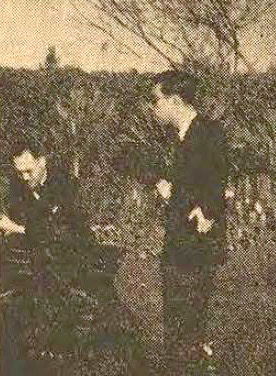 |
||
Mahmoud Saïd at the Mixed Tribunals of Egypt. |
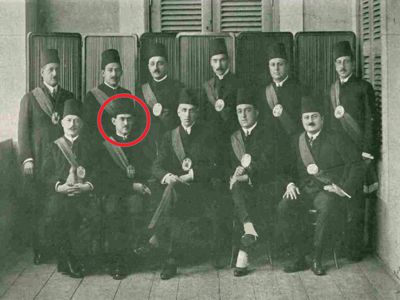 © J. Bouboulis |
||
|
|||
